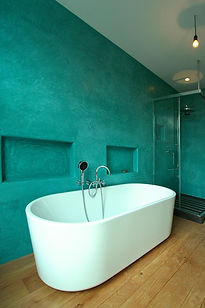Clay Building Materials
04/2017
Clay as a sustainable material source
One of the materials that can be used to develop sustainable buildings is clay. The best part of clay material is that it involves the firing of limestone and other components at temperatures above 1000 ° C without much processing other than removing it from the surface (For example, if we consider cement production. Therefore, the enormous energy consumption and therefore the possible increase in carbon emissions as well as the high costs. It is possible to use the materials in our houses without damaging the natural structure, preserving the properties it has and turning it into an advantage in buildings. In this way, production-induced emissions are reduced ( low "embodied energy" ) and economical solutions are offered. All these and the details described below make the use of clay material meaningful in any sustainable construction project.
Clay Material, Production and Usage Areas


Clay is an abundant material in nature and has the feature of absorbing water due to its structure. However, it is not possible to find clay in pure form in nature. Getting this material out of the ground is one of the most fundamental steps, and it is probably the process where the most energy is consumed during the entire production phase.
After the clay material is removed from the soil or sieved from other materials, water can be added to transform it into bricks, which is its most common use, or it can be made more durable by mixing natural and sustainable materials such as straw or sand to strengthen the natural material and can also be used as insulation material. ( photo source: http://endeavourcentre.org/2016/04/light-clay-straw-insulation/ )


For example, houses made of mud brick (clay mud, straw, water mixture) enabled them to be widely used in Anatolian villages because of being economical, keeping the heat and preventing dampness. Sumerians, its application was known in the time of Hittites. Houses with walls made of clay adobe materials in Wales have maintained their structure even after being exposed to weathering for centuries, and were not exposed to moisture, dampness and crumbling. ( photo source: http://www.daycreek.com/dc/HTML/DC_cob.htm & http://www.sehrivangazetesi.com/haber-asIrlIk-kerpic-evler-zamana-direniyor-34525.html )
In addition to its use as a solid building material, clay is used in interior wall, ceiling interior plaster, painting . It can be considered as an insulator for indoor air quality. The feature in its structure allows houses to be kept warm in winter and cool in summer and regulates humidity. In addition to contributing to achieving healthy and desired indoor air quality, it is a natural solution in terms of energy efficiency in buildings. For example, Tierrafino clay-based materials available in the market attract attention with their modern applications as in the photos below. Therefore, "I cannot stay in green houses", or "I live in the city center" etc. no need to complain. Because, clayey interior coatings have the features that will bring your home one step closer to nature.

In the short video below, the benefits of using clay paints and plasters in your home are explained by someone who has applied them.
Clay is a sustainable building material that has been used by mankind for centuries. Structures from the past to the present, in other words, the heritage of humanity are the clearest indicators that natural building materials such as clay can be used in buildings as a resource, can be easily obtained from the earth, and exhibit long durability performance regardless of climatic conditions.







